Tamilnadu State Board New Syllabus Samacheer Kalvi 12th Maths Guide Pdf Chapter 7 Applications of Differential Calculus Ex 7.6 Textbook Questions and Answers, Notes.
Tamilnadu Samacheer Kalvi 12th Maths Solutions Chapter 7 Applications of Differential Calculus Ex 7.6
Question 1.
Find the absolute extrema of the following functions on the given closed interval.
(i) f(x) = x² – 12x + 10; [1, 2]
(ii) f(x) = 3x4 – 4x³; [-1, 2].
(iii) f(x)= 6x\(\frac { 4 }{ 3 }\) – 3x\(\frac { 1 }{ 3 }\); [-1, 1]
(iv) f(x) = 2 cos x + sin 2x; [0, \(\frac { π }{ 2 }\) ]
Solution:
(i) f(x) = x² – 12x + 10;
f'(x) = 2x – 12
f'(x) = 0 ⇒ 2x – 12 = 0
x = 6 ∉ (1, 2)
Now, Evaluating f(x) at the end points x = 1, 2
f(1) = 1 – 12 + 10 = -1
f(2) = 4 – 24 + 10 = -10
Absolute maximum f(1) = -1
Absolute minimum f(2) = -10
![]()
(ii) f(x) = 3x4 – 4x3
f'(x) = 12x3 – 12x2
f'(x) = 0 ⇒ 12x2(x – 1) = 0
⇒ x = 0 or x = 1
[Here x = 0, 1 ∈ [-1, 2]]
Now f (-1) = 4
f(0) = 0
f(1) = -1
f(2) = 16
so absolute maximum = 16 and absolute minimum = -1
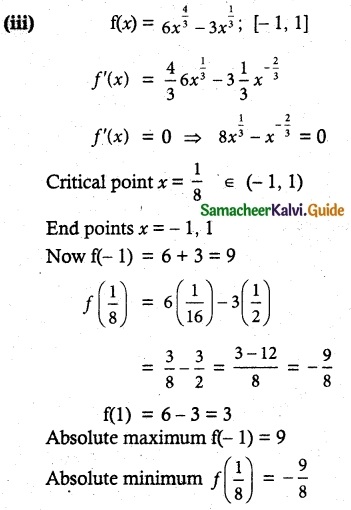
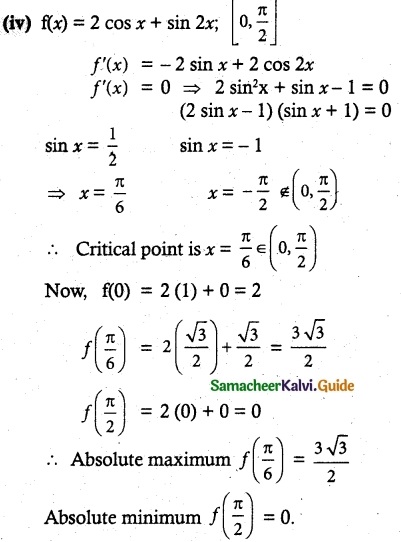
![]()
Question 2.
Find the intervals of monotonicities and hence find the local extremum for the following functions:
(i) f(x) = 2x³ + 3x² – 12x
(ii) f(x) = \(\frac { x }{ x-5 }\)
(iii) f(x) = \(\frac { e^x }{ 1-e^x }\)
(iv) f(x) = \(\frac { x^3 }{ 3 }\) – log x
(v) f(x) = sin x cos x+ 5, x ∈ (0, 2π)
Solution:
(i) f(x) = 2x³ + 3x² – 12x
f'(x) = 6x² + 6x – 12
f'(x) = 0 ⇒ 6(x² + x – 2) = 0
(x + 2)(x – 1) = 0
Stationary points x = -2, 1
![]()
Now, the intervals of monotonicity are
(-∞, -2), (-2, 1) and (1, ∞)
In (-∞, -2), f'(x) > 0 ⇒ f(x) is strictly increasing.
In (-2, 1), f'(x) < 0 ⇒ f(x) is strictly decreasing.
In (1, ∞), f'(x) > 0 ⇒ f(x) is strictly increasing.
f(x) attains local maximum as f'(x) changes its sign from positive to negative when passing through x = -2.
Local maximum
f(-2) = 2 (-8) + 3 (4) – 12 (-2)
= -16 + 12 + 24 = 20
f(x) attains local minimum as f'(x) changes its sign from negative to positive when passing through x = 1.
∴ Local minimum f(1) = 2 + 3 – 12 = -7
![]()
(ii) f(x) = \(\frac { x }{ x-5 }\)
f'(x) = \(\frac { (x-5)(1)-x(1) }{ (x-5)^2 }\) = –\(\frac { 5 }{ (x-5)^2 }\)
f'(x) = 0, which is absured
But in f(x) = \(\frac { x }{ x-5 }\)
The function is defined only when x < 5 or x > 5
∴ The intervals are (-∞, 5) and (5, ∞)
In the interval (-∞, 5), f'(x) < 0
In the interval (5, ∞), f'(x) < 0
∴ f(x) is strictly decreasing in (-∞, 5) and (5, ∞)
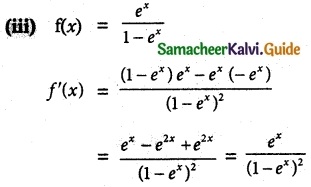
When x = 0, f(x) becomes undefined.
∴ x = 0 is an excluded value.
∴ The intervals are (-∞, 0) ∪ (0, ∞) in – (-∞, ∞), f'(x) > 0
∴ f(x) is strictly increasing in (- ∞, ∞) and there is no extremum.
(iv) f(x)= \(\frac { x^3 }{ 3 }\) – log x
f'(x) = x² – \(\frac { 1 }{ x }\)
f'(x) = 0 ⇒ x³ – 1 = 0 ⇒ x = 1
The intervals are (0, 1) and (1, ∞).
i.e., when x > 0, the function f(x) is defined in the interval (0, 1), f'(x) < 0
∴ f(x) is strictly decreasing in (0, 1) in the interval (1, ∞), f'(x) > 0
∴f(x) is strictly increasing in (1, ∞)
f(x) attains local minimum as f'(x) changes its sign from negative to positive when passing through x = 1
∴ Local minimum
f(1) = \(\frac { 1 }{ 3 }\) – log 1 = \(\frac { 1 }{ 3 }\) – 0 = \(\frac { 1 }{ 3 }\)
![]()
(v) f(x) = sin x cos x + 5, x ∈ (0, 2π)
f'(x) = cos 2x
f'(x) = 0 ⇒ cos 2x = 0
Stationary points
x = \(\frac { π }{ 4 }\), \(\frac { 3π }{ 4 }\), \(\frac { 5π }{ 4 }\), \(\frac { π }{ 4 }\) ∈x = (0, 2π)
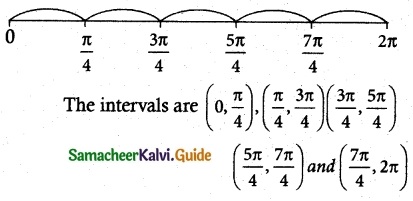
In the interval (0, \(\frac { π }{ 4 }\)), f'(x) > 0 ⇒ f(x) is strictly increasing.
In the interval (\(\frac { π }{ 4 }\), \(\frac { 3π }{ 4 }\)), f'(x) < 0 ⇒ f(x) is strictly decreasing.
In the interval (\(\frac { 3π }{ 4 }\), \(\frac { 5π }{ 4 }\)), f'(x) > 0 ⇒ f(x) is strictly increasing.
In the interval (\(\frac { 5π }{ 4 }\), \(\frac { 7π }{ 4 }\)), f'(x) < 0 ⇒ f(x) is strictly decreasing.
In the interval (\(\frac { 7π }{ 4 }\), 2π), f'(x) > 0 ⇒ f(x) is strictly increasing.
f'(x) changes its sign from positive to negative when passing through x = \(\frac { π }{ 4 }\) and x = \(\frac { 5π }{ 4 }\)
∴ f(x) attains local maximum at x = \(\frac { π }{ 4 }\) and \(\frac { 5π }{ 4 }\)

f'(x) changes its sign from negative to positive when passing through x = \(\frac { 3π }{ 4 }\) and x = \(\frac { 7π }{ 4 }\)
∴ f(x) attains local maximum at x = \(\frac { 3π }{ 4 }\) and x = \(\frac { 5π }{ 4 }\)
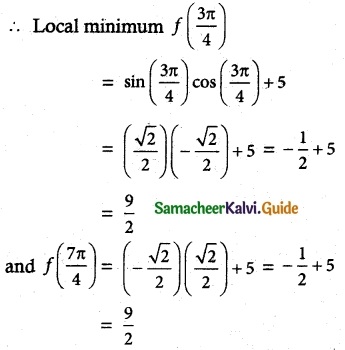
![]()